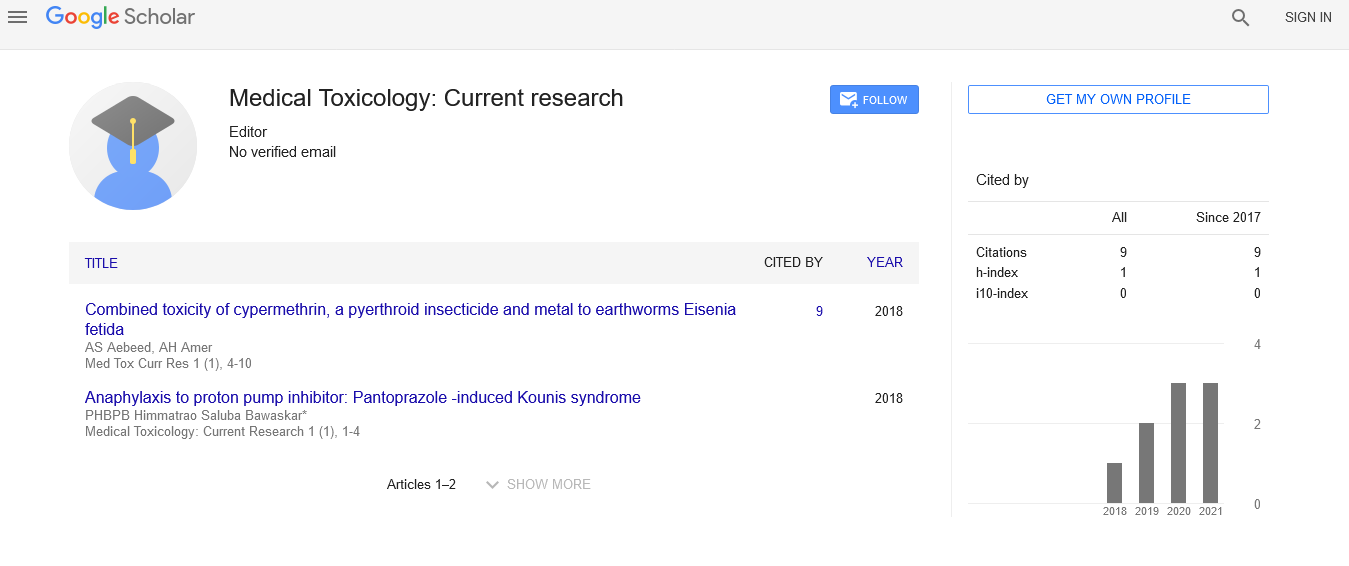An overview of renal toxicity and nephrotoxicity
Received: 14-Nov-2022, Manuscript No. PULMTCR -22- 5619; Editor assigned: 16-Nov-2022, Pre QC No. PULMTCR -22- 5619 (PQ); Reviewed: 30-Nov-2022 QC No. PULMTCR -22- 5619; Revised: 13-Jan-2023, Manuscript No. PULMTCR -22- 5619 (R); Published: 20-Jan-2023
Citation: Roy J. An overview of renal toxicity and nephrotoxicity. Med Toxicol: Curr Res 2023;6(1):1.
This open-access article is distributed under the terms of the Creative Commons Attribution Non-Commercial License (CC BY-NC) (http://creativecommons.org/licenses/by-nc/4.0/), which permits reuse, distribution and reproduction of the article, provided that the original work is properly cited and the reuse is restricted to noncommercial purposes. For commercial reuse, contact reprints@pulsus.com
Introduction
The word nephrotoxicity is a consolidation of two unique words nephron+harmfulness which implies kidney harming. Nephrotoxicity is otherwise called renal harmfulness is the gathering of poisonous substances/squanders in the kidney which impedes its generally expected working. It very well may be as well much serious and can cause casualty. We can say that it is only the noxious impact of certain substances like harmful synthetics and meds on the typical working. There are sure substances which are named as nephron poisons as they show nephrotoxicity for example numerous anticancer medications, a few ecological contaminations, antitoxins, radio difference specialists, sporting medications. Renal harmfulness is checked and is analyzed effectively by playing out a basic blood test [1,2].
Description
Nephrotoxicity can be effectively assessed by estimating the BUN (Blood Urea Nitrogen), levels of serum creatinine, glomerular filtration rate and leeway of creatinine. A low creatinine leeway demonstrates the unfortunate working of the kidney ordinary creatinine level is between 80 μ mol/L-120 μ mol/L in solid people. An ordinary creatinine level in solid people in the middle between 0.7 mg/dL to 1.3 mg/dL (61.9 μ mol/L to 114.9 μ mol/L) for men and 0.6 mg/dL to 1.1 mg/dL (53 μ mol/L to 97.2 μ mol/L) for ladies. If the creatinine level is more prominent than 1.2 for ladies and more noteworthy than 1.4 for men it is an early sign that the kidneys are not as expected working and it's chance to visit the medical services proficient and deal with your way of life and diet. In interventional radiology a patient's creatinine leeway levels are checked and surveyed prior to carrying out any methodology. It can cause the super durable kidney harm and the patient might need to take prescriptions life time or needs to go through dialysis in a few outrageous cases. Nephrotoxicity happens when kidney explicit detoxification and discharge don't work appropriately and their balance changes. Openness to drugs frequently results in poisonousness in kidney and certain sicknesses and ailments additionally lead to renal poisonousness like low circulatory strain for an extremely significant stretch of time, high glucose level for an extremely significant stretch of time, expand prostate organs in men. Types of renal harmfulness/nephrotoxicity: There are a few kinds of nephrotoxicity like cardiovascular renal poisonousness that happens because of the admission of cardiovascular medications by the patients for the most part talking because of purpose of normal medications of decision like general: Diuretics, β-blockers, vasodilator specialists and neighbourhood: Expert inhibitors, cyclosporine, tacrolimus. Interstitial nephritis likewise called by the name tubule interstitial nephritis which is the irritation of the region of the kidney called as renal interstitial [3,4].
There are many elements that incite the incendiary interaction inside the renal institium as are there some pharmacologic, natural, irresistible and foundational sickness patrons. It is available with a wide number of various signs and side effects that incorporates fever, exhaustion, queasiness, retching, and deficiency of weight. The vitally causative specialist is the utilization of pain relieving or anti-infection agents like the broad utilization of methicillin. This sickness is likewise brought about by other illnesses and the poisons develop harms the kidney [5].
Conclusion
It very well may be assessed via conveying a basic blood test which will decide an elevated degree of eosinophil's in the blood. There are a few different circumstances that moreover can create remembers an extremely high centralization of potassium for the blood, metabolic acidosis and disappointment of the kidney. Glomerulonephritis: An ordinarily utilized term depicts the hindrance of kidney because of aggravation both of glomeruli and of the little blood vessels in the kidneys, consequently the name. Signs and side effects are high protein content in the pee, increment fat in the blood. The nephritic disorder is portrayed by blood in the pee and a diminishing in the measure of pee within the sight of hypertension.
References
- Naughton CA. Drug induced nephrotoxicity. Am Fam Physician. 2008;78(6):743-50.
[Google Scholar] [PubMed]
- Arany I, Safirstein RL. Cisplatin nephrotoxicity. Semin Nephrol. 2003;23:(5)460-64.
[Crossref] [Google Scholar] [PubMed]
- Vial T, Descotes J. Clinical toxicity of the interferons. Drug Saf. 1994;10(2):115-50.
[Crossref] [Google Scholar] [PubMed]
- Baliga R, Ueda N, Walker PD, et al. Oxidant mechanisms in toxic acute renal failure. Drug Metab Rev. 1999;31(4):971-97.
[Crossref] [Google Scholar] [PubMed]
- Alfrey AC, Hegg A, Craswell P. Metabolism and toxicity of aluminum in renal failure. Am J Clin Nutr. 1980;33(7):1509-16.
[Crossref] [Google Scholar] [PubMed]





